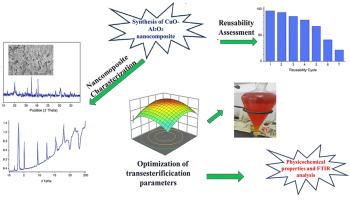Valorization of Carica papaya seed oil into biodiesel using a stable CuO–Al2O3 nanocatalyst under optimized condition
IF 5.8
2区 化学
Q2 CHEMISTRY, MULTIDISCIPLINARY
引用次数: 0
Abstract
This study investigates the extraction of biodiesel from Carica papaya L. seed oil, an underutilized, non-edible agricultural byproduct, using a copper oxide–alumina (CuO–Al2O3) nanocomposite as a catalyst in the transesterification process. The synthesized catalyst combined the high surface area of mesoporous γ-Al2O3 with the catalytic activity of dispersed CuO nanoparticles, as confirmed by SEM, XRD, EDX, and FTIR analyses. Key transesterification parameters, including nanocatalyst concentration (NCC), methanol-to-oil molar ratio (MOR), reaction temperature (RTP), and reaction time (RTE), were optimized using response surface methodology. ANOVA results indicated that RTE had the greatest effect on biodiesel yield (55.6 %), followed by MOR (24.1 %) and NCC (16.9 %). Optimal conditions (149 ppm NCC, 9:1 MOR, 70 °C RTP, and 92 min RTE) developed a maximum yield of 96.9 %, which was validated experimentally. The catalyst retained >95 % activity over five reuse cycles before gradual decline, confirming its reusability. FTIR confirmed ester carbonyl and methoxy groups, while fatty acid methyl ester profiling identified oleic acid methyl ester as the dominant component. The physicochemical propertiesD6751complied with ASTM D6751 and were close to EN 14214 requirements, with slight shortfalls in cetane number and oxidation stability that can be addressed by antioxidants or blending. These results demonstrate that papaya seed oil, in combination with a reusable CuO–Al2O3 catalyst under optimized conditions, can serve as a viable source for bioenergy extraction.

在优化条件下,用稳定的CuO-Al2O3纳米催化剂催化番木瓜籽油制备生物柴油
本研究研究了利用氧化铜-氧化铝(CuO-Al2O3)纳米复合材料作为酯交换过程催化剂,从番木瓜籽油(一种未充分利用的非食用农业副产品)中提取生物柴油。合成的催化剂结合了介孔γ-Al2O3的高表面积和分散的CuO纳米颗粒的催化活性,通过SEM, XRD, EDX和FTIR分析证实了这一点。利用响应面法对纳米催化剂浓度(NCC)、醇油摩尔比(MOR)、反应温度(RTP)和反应时间(RTE)等关键酯交换参数进行优化。方差分析结果表明,RTE对生物柴油产量的影响最大(55.6%),其次是MOR(24.1%)和NCC(16.9%)。优化条件为:NCC 149 ppm、MOR 9:1、RTP 70°C、RTE 92 min,产率最高可达96.9%。该催化剂在5次重复使用循环中保持了95%的活性,然后逐渐下降,证实了其可重复使用。FTIR鉴定了酯羰基和甲氧基,脂肪酸甲酯谱鉴定了油酸甲酯为主要成分。物理化学性质D6751符合ASTM D6751,接近EN 14214要求,十六烷值和氧化稳定性略有不足,可以通过抗氧化剂或混合来解决。这些结果表明,在优化条件下,木瓜籽油与可重复使用的CuO-Al2O3催化剂结合,可以作为生物能源提取的可行来源。
本文章由计算机程序翻译,如有差异,请以英文原文为准。
求助全文
约1分钟内获得全文
求助全文
来源期刊

Sustainable Chemistry and Pharmacy
Environmental Science-Pollution
CiteScore
8.20
自引率
6.70%
发文量
274
审稿时长
37 days
期刊介绍:
Sustainable Chemistry and Pharmacy publishes research that is related to chemistry, pharmacy and sustainability science in a forward oriented manner. It provides a unique forum for the publication of innovative research on the intersection and overlap of chemistry and pharmacy on the one hand and sustainability on the other hand. This includes contributions related to increasing sustainability of chemistry and pharmaceutical science and industries itself as well as their products in relation to the contribution of these to sustainability itself. As an interdisciplinary and transdisciplinary journal it addresses all sustainability related issues along the life cycle of chemical and pharmaceutical products form resource related topics until the end of life of products. This includes not only natural science based approaches and issues but also from humanities, social science and economics as far as they are dealing with sustainability related to chemistry and pharmacy. Sustainable Chemistry and Pharmacy aims at bridging between disciplines as well as developing and developed countries.
 求助内容:
求助内容: 应助结果提醒方式:
应助结果提醒方式:


